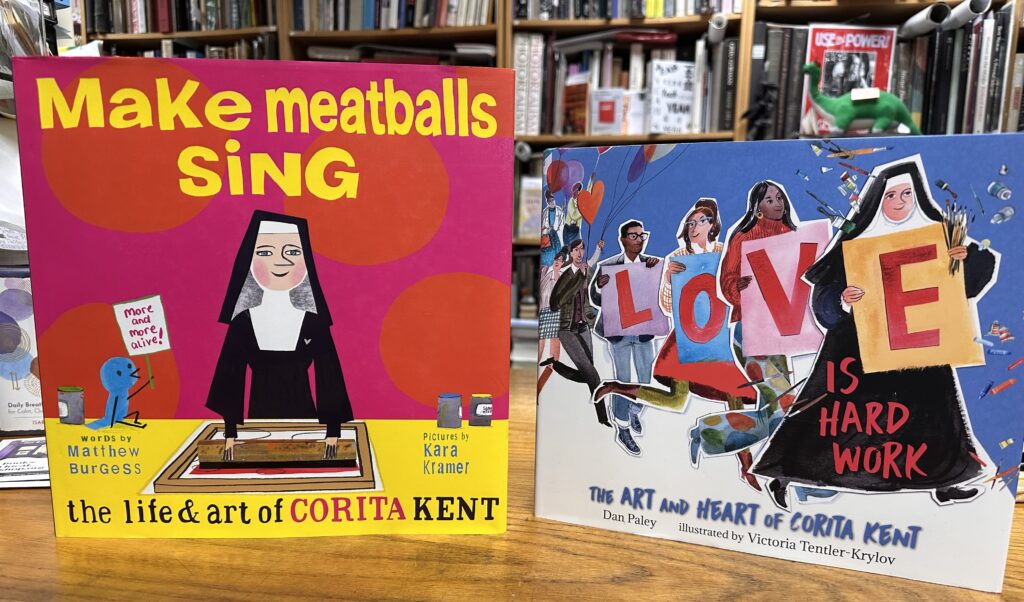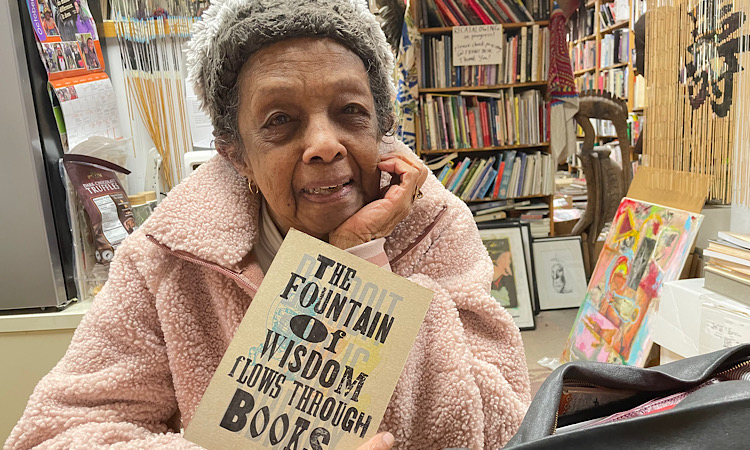[Editor’s note: We received several positive comments on an interview post with our friend and retired English teacher Shirley Tinsley back in March, so we decided to ask her for a list of some of her favorite books. Shirley is a member of our reading group and born nearly a century ago, upbeat, and a passionate lover of books. On Bookstore day, (the last Saturday in April), her daughter delivered an eleven page “bulk” hand-written letter in beautiful cursive. We were thrilled to read it and share it now.]
Dear Book Beat,
When I write to my nephew’s—one about to graduate from med school at Mount Sinai in New York City, and the other about to enter law school at Stanford—they say I am sending them bulk mail because I am so detailed in what I say, and they have trouble reading cursive. All that to say I am sending you this bulk mail in response to your asking for ten book titles. That is what happens when you communicate with a nonagenarian!!!
I do so love words which is one reason my bookshelf is fuller with lyrics—from Gershwin to Sondheim to Lin Miranda. How do they put those words together? It is magic to me. Who, but a genius like Billy Strayhorn, would think to rhyme “awful” with “trough full?”
I speak of lyrics because the first work I am suggesting contains lyrics and melodies we never would have known had it not been for some long-sighted scholars who recognized their value, listened to those above who could remember and sing them, and wrote them in both the langauge of musical notes and English words. It took sixty years after the Civil War for this to be accomplished, but in 1925 The Books of the American Negro Spirituals was first published and is still available.
James Weldon Johnson, the poet who wrote “Black and Unknown Bards” and also “Lift Every Voice and Sing” wrote the prefaces to both volumes of the book which comprises one book.
What a loss it would have been for our historical record not to know these “folk” songs existed and for posterity not to be able to regard them with the acclaim they deserve. For a book reading club they may not be suitable, but the club should be aware of them. Through the efforts of Fisk, Hampton, and Tuskegee Universities, these songs were presented to the world. Fisk Jubilee Singers were welcome all over the world. Rosamond, James’ brother, was an expert on the spirituals and did the musical arrangements.
The Paper Garden—Molly Peacock
I love this book and it gave me great pleasure to know she not only introduced collage as an artistic endeavor in the 1700’s, but started at age 72. And her works were not only botanically correct, but can still be seen in the British Museum. Healthy older age—even very old (say 98 like me) is no deterrent to creativity!!
The Water Dancer—Ta-Nehesi Coates
His first novel I believe. I liked this story and it made me think of how many books by black authors talkk about water. Our friend, Betty Neals, tells stories about her grandmother talking about water (she grew up in Florida). Do you think the journey by ship from Africa or the islands was absorded into the psyche—and passed on—to succeeding generations?
Braiding Sweetgrass—Robin Wall Kimmerer
Not only did I love reading this, but I sent it to many friends. I think we need to be more aware of indigenous wisdom and what it adds to our knowledge. Did you know our constitution was based partly on the Iroquois idea of a collection of native states? There is a history of our constitution written by a Yale professor that gives details and documentation of this—the name is in the cloud at the moment. [ Perhaps it was Ned Blackhawk’s The Rediscovery of America, winner of the National Book Award, 2023.-Ed. note.]
Century Cycle—August Wilson
A play for each decade. May not be appropriate for a reading club, but worth reading/seeing. I remember when Ma Rainey’s Black Bottom was performed at the Attic Theater here using local actors and I took several classes to see it and saw it later with my husband and several friends for whom I had gotten tickets. I thought that was important. August Wilson gave permission for parts of Fences to be included in the textbook I helped put together for Holt Rinehart. I was the last man on the totem pole because college professors wrote essays and experienced others gathered art and permissions for other entries. Our friend, Betty Neals, took acting classes from Floyd Richards, the director at Yale School of Drama where were staged early some of Wilson’s plays.
Kindred—Octavia Butler
I never was too interested in sci-fi, but this book intrigued me and I read it almost in one sitting—neglecting everything else I had to do. Who would ever think of putting slavery and time travel together.
An Unfinished Love Story—Doris Kearns Goodwin
I am a fan of Doris Kearns Goodwin and think her writing is superb! This story about her and her husband held my attention, maybe because I remember the times and events she recalls of them and her husband.
An Illuminated Life—Heidi Ardizzone
Today is April 24, 2025. Exactly 100 years ago on April 24, 1924, J.P. Morgan II transformed his father’s private library to a public space. Belle da Costa Greene was responsible for the elder Morgan’s purchase of illuminated literary and musical works. The library also holds three Gutenbuerg bibles, a lot of Byron, Dickens, Ruskin, Twain, and Melville, in addition to early children’s books. That she (Belle) was able to function and hide her black heritage was remarkable. I have visited the Morgan and have seen her office which is spectacular. My other reason for reading this book was that my daughter in art history classes at the University of Michigan in the 1980s used a text by Bernard Berenson, the scholar of Italian art and the paramour of Belle. Belle destroyed all of his letters to her, but her letters to him are available to read at Harvard.
The 272—Rachel Swarns
I read this book mainly because my younger daughter graduated from Georgetown and used to talk about “these old Jesuits.” At her graduation most of the graduates wore banners over their graduation gown advocating divestment from South Africa because of apartheid. What if they had known then about the 272 families that were sold to save the college and truly—Catholicism in Maryland. Following the Mahoney family truly interested me.

Sister Mary Corita
I am listing here some children’s books (which I purchased at Book Beat) if any readers have children or younger people in their lives. Not only does her perpective help one see ordinary things differently, it may spark a curiosity and interest beyond all of the technology that takes up most of their time—and that of their parents too. Using a magnifying glass to look at something very ordinary may make one more perceptive about what surrounds us.
For grown ups my favorites are:
Corita Kent. Art and Soul. The Biography—April Dammann
Learning By Heart: Teachings to Free the Creative Spirit— by
Corita Kent and Jan Steward
The Spitited Art of Sister Corita Kent [for those just interested in her printing and art -Ed. note]
Ideas adaptable for many creative activities: Only a few of the children and YA
Make Meatballs Sing: The Life and Art of Corita Kent
Love is Hard Work: The Art and Heart of Corita Kent by Dany Paley (words) and illustrated by Victoria Tentler-Krylov
When I was working with the Army at Fort Leonard Wood, Missouri, most of the servicemen were young men serving their two year draft obligation after having been deferred for college. One of the young men I knew was a native of Erie, Pennsylvania and a graduate of University of Detroit in the School of Architecture. For one of the parties we put on for the soldiers, we needed a teahouse entrance that looked like a thatched roof. Conrad magically supplied that for us out of brown craft paper and our “Teahouse of the August Moon” party was a great success both visually and gastronomically because Japanese wives of some soldiers made the food on site with electric skillets and a four-burner gas stove.
Conrad Krause was the soldiers name and we became good friends. When his two years were up, he took a year to travel the US and to make the decision whether or not to become a priest. During that time he visited Sister Corita Kent’s studio. Little did I know I would meet him again when I married a Detroiter and Conrad had an assignment at the seminary on Chicago Blvd. He indeed became a priest, and got in touch with me here and came to visit bearing a Corita Kent seriograph he had gotten for me on his decision tour. That was my first introduction to Corita. I now have three prints—gifts—in my kitchen and one he have in my livingroom.
Shortly after Conrad’s visit in 1962 (I know the date because Kim was a small baby and he asked if he could hold her—which seemed to give him great pleasure), Corita had a show at Cranbrook. I remember the press and great controversy because one of her prints was a huge ripe red tomato and her writing on it was “Mary was like a ripe tomato.” Both the Detroit Free Press and the Detroit News carried articles saying that her words were a sacrilege.
I also remember that she and her students were invited sometine in the sixties to decorate the many white walls at the sets where the World Council of Churches was meeting in Upsala, Sweden. Of course her bright colors and writings were a sensation for the conference attendees. She and her students had a big laugh that so many of the attendees were writing in their notebooks the words she had written on each colorful serigraph. All of the words were from the bible!!
[ Ed. note: In the 1960s, Corita Kent, the artist and nun, had ten rules for students and teachers, focused on fostering creativity, trust, and self-discipline. These rules emphasized active learning, embracing experimentation, and not being afraid to break the rules, even one’s own. Their contributions comprised the now widely recognizable Immaculate Heart College Art Department Rules (commonly referred to as “Ten Rules”).]
Now you have experienced one of my bulk mail pieces—except I am going to hand it to you this weekend—or leave it in the store for you.
Thank you for giving me the opportunity to EXPOUND!! Ha
Signed: S. Tinsley
P.S. I have gone through many “periods” of reading in my life—the English novel, the Russian novel, the historical novel, etc. Now I read fewer fiction but more factual books like biographies, history, memoirs, etc.
![]()


